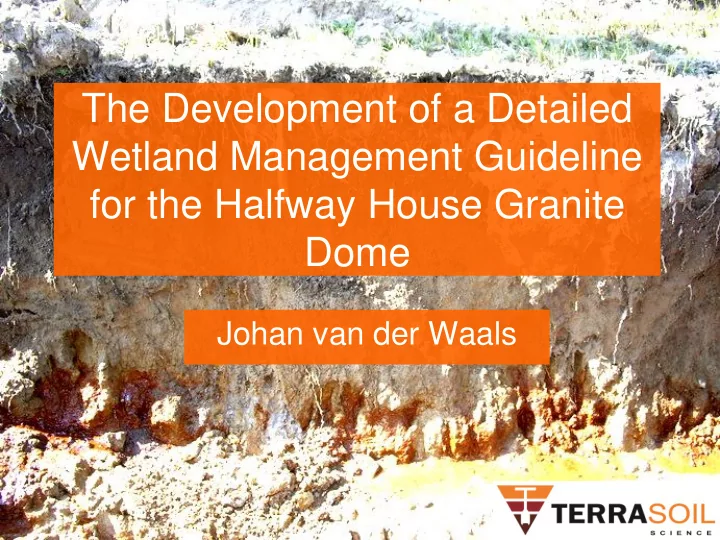

The Development of a Detailed Wetland Management Guideline for the Halfway House Granite Dome Johan van der Waals
Why do we end up with “ bleeding ” wetlands?
2008 09 07
Why do we end up with destroyed wetlands? 2009 11 12
Pan African Parliament Site Wetland Grass Owl
Why do we end up with eroded wetlands?
Challenging Process! Regulator ? EAP Applicant Regulation in a context of insufficient information and understanding!
Challenging Process! • Regulator – Responsibility ito existing legal framework – What happens if there are gaps? • Client – Wants to develop/use – Economic imperatives • EAP – Responsibility to elucidate science – Guide process ito science, best practice and legal framework
Identification of Gaps • Urban wetlands need to be considered in an urban context • Ecological parameters are challenging at best and will change with development • Wetlands cannot be considered in isolation wrt hydrological drivers • Major knowledge gap exists in wetland assessment process to account for hydrological drivers!
Example • Wetland delineation guidelines – Four indicators – Soil wetness indicator not defined ito context • Variable identification of wetland parameters • Land types – Bb 75% – Ba 12% – Ab < 2%
Precipitation (100 %) Evapotranspiration (< 30 %) Surface runoff (6 %) Sub-surface lateral drainage (> 60 %) Recharge (4 %)
Glencoe < 0.5 m Wasbank Wasbank Wasbank Longlands Katspruit Kroonstad Champagne Fluctuating water table Increasingly permanent water table
Convex Landscape Diverging water flow Glenrosa Glencoe Glencoe Glencoe Glencoe Wasbank Wasbank Concave Landscape Converging water flow Wasbank Wasbank Wasbank Wasbank Longlands Kroonstad / Longlands Estcourt
Soil hydrological zones Convex Concave Concave Convex Shallow Interflow / Thick Interflow / Thicker Interflow Recharge Zone Return Flow Zone Deposition Zone Zone
Anatomy of a Wetland Disaster • Step 1: Identification of site for development • Step 2: Delineation of wetland conducted predominantly on ecological parameters (no consideration to landscape hydrological drivers!) • Step 3: Regulator issues ROD and requires 30m buffer on wetland • Step 4: Site is developed, 30 m outside wetland • Step 5: Poorly or non-mitigated storm water destroys wetland within 5 years – nothing left of original wetland (impirical proof of concept already conducted) • What are the implications and who is responsible?
Anatomy of a Wetland Disaster • Wetlands on the HHGD cannot attenuate floods! • Wetlands are in equilibrium with natural conditions (before human impacts) • Erosion sets in with runnof increasing by as little as 5 % • The wetland soils are: – Dispersive due to dominant clays – Often sandy with no cohesion between soil particles – 100 to 500 % more erodible once saturated with water
Solution! How?? • Proper understanding of biophysical context with hydrology being the key • Focus on integration of hydrological assessments – hydropedology • Must be accessible by public, regulator and assessors/specialists alike!
Hydropedology? • Integration of the disciplines of hydrology and pedology (understanding, description and classification of soils) • Soils influence hydrology (texture, structure, etc.) but also provide indicators of hydrology (redox morphology, soil physics, etc.) • Soils are therefore both indicators and participators in landscape hydrology = ideal tool for description
Draft Guidelines • Statutory context of wetlands and delineation (criminal vs administrative law) • Biophysical context – Soils • Morphology and classification (Hydropedology) • Topography and erosion susceptibility • Description of hydrological drivers – Hydrological changes due to human activities • Post development context – Storm water management as part of a broader environment • Case Studies
Case Studies • Erosion of wetlands – Storm water planning problems – Regulatory problems – by-laws and storm water release authorization • Wetland delineation problems – Soil classification – Interpretation of hydromorphology • Artificial modifiers not considered in assessments • Reference state not considered for PES • Inconsistent application of regulations
Conclusions • HHGD wetlands – Under siege – Highly erodible – Cannot attenuate floods!!!! • Landscape (entire) and wetland assessment currently inadequate – PES – “reference state”!? – Artificial modifiers identification and elucidation? – Integrated hydrology assessment • Groundwater hydrology • Surface water hydrology • Interflow / Vadose zone hydrology
Conclusions • Delineation challenging – Decide on context and relevance! – Solution – hydropedology of entire catchment? • Landscape (entire) and wetland management currently inadequate – Storm water management – By-laws governing storm water release authorization – Buy-in by developers – Latent liabilities (Section 28 NEMA?)
The Development of a Detailed Wetland Management Guideline for the Halfway House Granite Dome Johan van der Waals
Recommend
More recommend